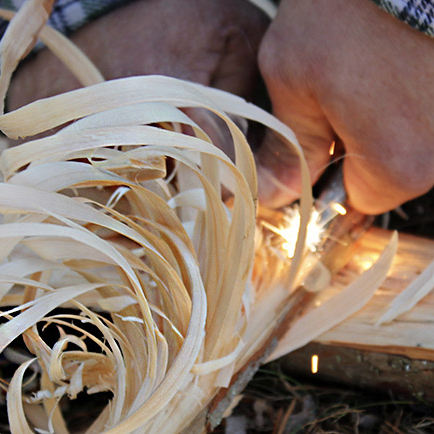7 things you need to know about building a campfire
It seems that fewer and fewer of us know how to successfully build a campfire – so we have talked to survival expert and course leader Mattias Norberg, who has been trained by survival organisation Swedish Survival Guild.
1. How can I light a fire with wet wood? Collect wood according to size, from the finest twigs to thicker branches. Heartwood from pines, also known as fatwood, will burn even in the rain. Sometimes you can split an entire heartwood log and burn it. Or you can start your fire with heartwood and then put other wood on it once it’s burning well. When it’s raining and everything is damp, put a lot of wood on the fire so it dries out as the fire burns. Make sure you leave plenty of space between the pieces; air needs to get in for it to burn. Bark dries quickly and burns even in bad weather, so it is great to start a fire with. If you have an axe, you can harvest wood from bigger dead trees that are still standing. The wood in the middle will be dry, even if it’s raining. Use your axe to get to the dry heartwood. Making a so-called “feather stick” is a good idea if are dealing with damp wood. Make a few of these with a knife and use them to light your fire. Light the dry wood in the middle until you have a good base to your fire, then you can add other wood while you also dry wood by placing it close to the fire.

Tip: Light a large lump of wood with a lot of sap. It will burn for a long time and you have a better chance of your kindling catching fire.
2. How do I make a good campfire for cooking over? I prefer to cook over embers to open flames. So it’s an advantage if you can burn harder kinds of wood (with a higher density) such as oak, beech and even birch works well as you will get more embers from these. To get a good bed of embers, you can make any kind of fire you want but a hydrid kind of fire combining a tipi with a log cabin style, or an upside down fire, work well. You can then place your pot/frypan directly on the embers or hang it above – both work fine.

3. What material is best to use to get a “fireball”? If the material is completely dry, several kinds can work really well. But, regardless of the weather, dry material you can always get hold of is wood from the inside of dead trees that are still standing. From this wood, make some nice fluffy feather sticks. These work perfectly to make a fire ball. Then we can use dry bark, reeds, or grass, e.g. canary grass. These all grow just like reeds, and they dry really quickly in the wind. Dry rotten wood is also good to combine with other material.
4. Can you give me any tips on how to make a good feather stick? A good method of making a feather stick is, with the blade of the knife facing away from you, run it down the stick, shaving small strips off it at almost the same angle as the stick. Be sure to stop before reaching the end of the stick so the strips remain attached. It is all about the angle of the knife blade on the stick. It’s a great skill to practice before you really need it.

5. What are your best “cheat ideas” for lighting a fire easily? I usually say there is no such thing as cheating when it comes to lighting a fire. As long as you get it lit, everything is allowed. But sure, there are people who think that using materials that aren’t taken directly from nature is cheating. This might include tampons or cotton dipped in Vaseline, pieces of a bicycle tyre, paper drenched in paraffin, tealight candles, etc. These all increase your chances of successfully lighting a fire.
6. How can you get a concentrated rain of sparks from your fire steel? You can use your fire steel in a number of ways. It’s hard to describe in words but a powerful stroke along the entire length of the steel using the same angle is a good start. The sparks will always spread out a bit. More precision is possible if you use the outermost 1-2 cm of the steel and push firmly away with your thumb placed on the instrument you are using to scrape the steel.
7. What are the three most important components to making a good fire? The three most important things are using dry material, having enough heat and enough oxygen. This also applies when you are taking care of your fire and adding more fuel. As a rule, have about 1-2 fingers' worth of space between pieces of wood so that they burn well.
Always remember to light campfires responsibly and follow any fire restrictions in the area. The text above gives you tips on how to light a campfire when you are in the outdoors.
5 Tips for choosing a campsite
Break free from designated camp grounds and find your own slice of camping paradise.
